Soil Organic Carbon Estimation via Remote Sensing and Machine Learning Techniques: Global Topic Modeling and Research Trend Exploration
Abstract
1. Introduction
2. Materials and Methods
2.1. Literature Retrieval Methods
2.2. BERTopic Modeling Methods
2.2.1. Data Preprocessing
2.2.2. Topic Selection, Keyword Analysis, and Model Accuracy
2.2.3. Visualization and Additional Analysis Methods
2.3. Other Visualization Methods
3. Results
3.1. Basic Publication Statistics
3.2. Research Trends and Landscape of SOC Estimation Using RS Techniques
3.2.1. The Utilization Frequency of Different RS Platforms
3.2.2. BERTopic Modeling Analysis for Studies of SOC Estimation Using RS
3.3. Research Landscape of SOC Estimation via RS and ML Techniques
3.3.1. Author Keyword Co-Occurrence Analysis
3.3.2. Dynamics and Characterization of Author Keywords and Keywords Plus over Time
3.3.3. BERTopic Modeling
4. Discussion
4.1. BERTopic Modeling Clusters for SOC with RS Techniques
4.2. Relationship between SOC Estimation and ML and RS Techniques
4.2.1. Keyword Clustering and Dynamics in SOC Research
4.2.2. In-Depth Analysis of BERTopic Modeling Clusters
4.3. Challenges in the Integration of RS and ML Techniques for SOC Estimation
4.4. Limitations
5. Conclusions
Author Contributions
Funding
Data Availability Statement
Conflicts of Interest
References
- Sommer, R.; Bossio, D. Dynamics and climate change mitigation potential of soil organic carbon sequestration. J. Environ. Manag. 2014, 144, 83–87. [Google Scholar] [CrossRef] [PubMed]
- Lal, R. Digging deeper: A holistic perspective of factors affecting soil organic carbon sequestration in agroecosystems. Glob. Chang. Biol. 2018, 24, 3285–3301. [Google Scholar] [CrossRef]
- Hernandez-Morcillo, M.; Burgess, P.; Mirck, J.; Pantera, A.; Plieninger, T. Scanning agroforestry-based solutions for climate change mitigation and adaptation in Europe. Environ. Sci. Policy 2018, 80, 44–52. [Google Scholar] [CrossRef]
- Minasny, B.; Malone, B.P.; McBratney, A.B.; Angers, D.A.; Arrouays, D.; Chambers, A.; Chaplot, V.; Chen, Z.-S.; Cheng, K.; Das, B.S.; et al. Soil carbon 4 per mille. Geoderma 2017, 292, 59–86. [Google Scholar] [CrossRef]
- Scialabba, N.E.H.; Muller-Lindenlauf, M. Organic agriculture and climate change. Renew. Agric. Food Syst. 2010, 25, 158–169. [Google Scholar] [CrossRef]
- Dong, S.K.; Shang, Z.H.; Gao, J.X.; Boone, R.B. Enhancing sustainability of grassland ecosystems through ecological restoration and grazing management in an era of climate change on Qinghai-Tibetan Plateau. Agric. Ecosyst. Environ. 2020, 287, 106684. [Google Scholar] [CrossRef]
- Jiang, C.; Zhang, L. Ecosystem change assessment in the Three-river Headwater Region, China: Patterns, causes, and implications. Ecol. Eng. 2016, 93, 24–36. [Google Scholar] [CrossRef]
- Burle, M.L.; Mielniczuk, J.; Focchi, S. Effect of cropping systems on soil chemical characteristics, with emphasis on soil acidification. Plant Soil 1997, 190, 309–316. [Google Scholar] [CrossRef]
- Bandara, T.; Franks, A.; Xu, J.; Bolan, N.; Wang, H.; Tang, C. Chemical and biological immobilization mechanisms of potentially toxic elements in biochar-amended soils. Crit. Rev. Environ. Sci. Technol. 2020, 50, 903–978. [Google Scholar] [CrossRef]
- Xu, Z.; Tsang, D.C. Redox-induced transformation of potentially toxic elements with organic carbon in soil. Carbon Res. 2022, 1, 9. [Google Scholar] [CrossRef]
- Zhu, X.B.; He, H.L.; Ma, M.G.; Ren, X.L.; Zhang, L.; Zhang, F.W.; Li, Y.N.; Shi, P.L.; Chen, S.P.; Wang, Y.F.; et al. Estimating Ecosystem Respiration in the Grasslands of Northern China Using Machine Learning: Model Evaluation and Comparison. Sustainability 2020, 12, 2099. [Google Scholar] [CrossRef]
- Wang, S.; Guan, K.; Zhang, C.; Lee, D.; Margenot, A.J.; Ge, Y.; Peng, J.; Zhou, W.; Zhou, Q.; Huang, Y. Using soil library hyperspectral reflectance and machine learning to predict soil organic carbon: Assessing potential of airborne and spaceborne optical soil sensing. Remote Sens. Environ. 2022, 271, 112914. [Google Scholar] [CrossRef]
- Zhou, Y.; Zhao, X.; Guo, X.; Li, Y. Mapping of soil organic carbon using machine learning models: Combination of optical and radar remote sensing data. Soil Sci. Soc. Am. J. 2022, 86, 293–310. [Google Scholar] [CrossRef]
- Angelopoulou, T.; Tziolas, N.; Balafoutis, A.; Zalidis, G.; Bochtis, D. Remote sensing techniques for soil organic carbon estimation: A review. Remote Sens. 2019, 11, 676. [Google Scholar] [CrossRef]
- Li, T.; Xia, A.; McLaren, T.I.; Pandey, R.; Xu, Z.; Liu, H.; Manning, S.; Madgett, O.; Duncan, S.; Rasmussen, P. Preliminary Results in Innovative Solutions for Soil Carbon Estimation: Integrating Remote Sensing, Machine Learning, and Proximal Sensing Spectroscopy. Remote Sens. 2023, 15, 5571. [Google Scholar] [CrossRef]
- Silvero, N.E.; Demattê, J.A.; Minasny, B.; Rosin, N.A.; Nascimento, J.G.; Albarracín, H.S.R.; Bellinaso, H.; Gómez, A.M. Sensing technologies for characterizing and monitoring soil functions: A review. Adv. Agron. 2023, 177, 125–168. [Google Scholar]
- Thulin, S.; Hill, M.J.; Held, A.; Jones, S.; Woodgate, P. Hyperspectral determination of feed quality constituents in temperate pastures: Effect of processing methods on predictive relationships from partial least squares regression. Int. J. Appl. Earth Obs. Geoinf. 2012, 19, 322–334. [Google Scholar] [CrossRef]
- Darvishzadeh, R.; Skidmore, A.; Schlerf, M.; Atzberger, C.; Corsi, F.; Cho, M. LAI and chlorophyll estimation for a heterogeneous grassland using hyperspectral measurements. ISPRS J. Photogramm. Remote Sens. 2008, 63, 409–426. [Google Scholar] [CrossRef]
- Kumar, M.; Kumar, A.; Thakur, T.K.; Sahoo, U.K.; Kumar, R.; Konsam, B.; Pandey, R. Soil organic carbon estimation along an altitudinal gradient of chir pine forests in the Garhwal Himalaya, India: A field inventory to remote sensing approach. Land Degrad. Dev. 2022, 33, 3387–3400. [Google Scholar] [CrossRef]
- Odebiri, O.; Odindi, J.; Mutanga, O. Basic and deep learning models in remote sensing of soil organic carbon estimation: A brief review. Int. J. Appl. Earth Obs. Geoinf. 2021, 102, 102389. [Google Scholar] [CrossRef]
- Angelopoulou, T.; Balafoutis, A.; Zalidis, G.; Bochtis, D. From laboratory to proximal sensing spectroscopy for soil organic carbon estimation—A review. Sustainability 2020, 12, 443. [Google Scholar] [CrossRef]
- Yuzugullu, O.; Lorenz, F.; Fröhlich, P.; Liebisch, F. Understanding Fields by Remote Sensing: Soil Zoning and Property Mapping. Remote Sens. 2020, 12, 1116. [Google Scholar] [CrossRef]
- Xiao, J.; Chevallier, F.; Gomez, C.; Guanter, L.; Hicke, J.A.; Huete, A.R.; Ichii, K.; Ni, W.; Pang, Y.; Rahman, A.F. Remote sensing of the terrestrial carbon cycle: A review of advances over 50 years. Remote Sens. Environ. 2019, 233, 111383. [Google Scholar] [CrossRef]
- Li, T.; Cui, L.; Xu, Z.; Hu, R.; Joshi, P.K.; Song, X.; Tang, L.; Xia, A.; Wang, Y.; Guo, D.; et al. Quantitative analysis of the research trends and areas in grassland remote sensing: A scientometrics analysis of web of science from 1980 to 2020. Remote Sens. 2021, 13, 1279. [Google Scholar] [CrossRef]
- Liu, H.; Cui, L.; Li, T.; Schillaci, C.; Song, X.; Pastorino, P.; Zou, H.; Cui, X.; Xu, Z.; Fantke, P. Micro- and Nanoplastics in Soils: Tracing Research Progression from Comprehensive Analysis to Ecotoxicological Effects. Ecol. Indic. 2023, 156, 111109. [Google Scholar] [CrossRef]
- Wang, Z.; Chen, J.; Chen, J.; Chen, H. Identifying interdisciplinary topics and their evolution based on BERTopic. Scientometrics 2023, 1–26. [Google Scholar] [CrossRef]
- McInnes, L.; Healy, J.; Melville, J. Uniform manifold approximation and projection for dimension reduction. arXiv 2020, arXiv:1802.03426. [Google Scholar]
- Wang, B.; Kuo, C.-C.J. Sbert-wk: A sentence embedding method by dissecting bert-based word models. IEEE/ACM Trans. Audio Speech Lang. Process. 2020, 28, 2146–2157. [Google Scholar] [CrossRef]
- Grootendorst, M. BERTopic: Neural topic modeling with a class-based TF-IDF procedure. arXiv 2022, arXiv:2203.05794. [Google Scholar]
- Axelborn, H.; Berggren, J. Topic Modeling for Customer Insights: A Comparative Analysis of LDA and BERTopic in Categorizing Customer Calls. Master’s Thesis, Umeå University, Umeå, Sweden, 2023. [Google Scholar]
- Atzeni, D.; Bacciu, D.; Mazzei, D.; Prencipe, G. A Systematic Review of Wi-Fi and Machine Learning Integration with Topic Modeling Techniques. Sensors 2022, 22, 4925. [Google Scholar] [CrossRef]
- Devlin, J.; Chang, M.-W.; Lee, K.; Toutanova, K. Bert: Pre-training of deep bidirectional transformers for language understanding. arXiv 2018, arXiv:1810.04805. [Google Scholar]
- Frick, R.A.; Vogel, I. Fraunhofer SIT at CheckThat! 2022: Ensemble similarity estimation for finding previously fact-checked claims. In Proceedings of the CLEF 2022: Conference and Labs of the Evaluation Forum, Bologna, Italy, 5–8 September 2022; Notes of CLEF. pp. 5–8. [Google Scholar]
- Yu, C.-W.; Chuang, Y.-S.; Lotsos, A.N.; Haase, C.M. Decoding Affect in Dyadic Conversations: Leveraging Semantic Similarity through Sentence Embedding. arXiv 2023, arXiv:2309.12646. [Google Scholar]
- McInnes, L.; Healy, J.; Melville, J. UMAP: Uniform Manifold Approximation and Projection. J. Open Source Softw. 2018, 3, 861. [Google Scholar] [CrossRef]
- Aytaç, E.; Khayet, M. A Topic Modeling Approach to Discover the Global and Local Subjects in Membrane Distillation Separation Process. Separations 2023, 10, 482. [Google Scholar] [CrossRef]
- Yang, D.; Wei, V.; Jin, Z.; Yang, Z.; Chen, X. A UMAP-based clustering method for multi-scale damage analysis of laminates. Appl. Math. Model. 2022, 111, 78–93. [Google Scholar] [CrossRef]
- McInnes, L.; Healy, J.; Astels, S. hdbscan: Hierarchical density based clustering. J. Open Source Softw. 2017, 2, 205. [Google Scholar] [CrossRef]
- Bushra, A.A.; Yi, G. Comparative analysis review of pioneering DBSCAN and successive density-based clustering algorithms. IEEE Access 2021, 9, 87918–87935. [Google Scholar] [CrossRef]
- Abuzayed, A.; Al-Khalifa, H. BERT for Arabic topic modeling: An experimental study on BERTopic technique. Procedia Comput. Sci. 2021, 189, 191–194. [Google Scholar] [CrossRef]
- van Eck, N.J.; Waltman, L. Software survey: VOSviewer, a computer program for bibliometric mapping. Scientometrics 2010, 84, 523–538. [Google Scholar] [CrossRef]
- Bin, C.; Weiqi, C.; Shaoling, C.; Chunxia, H. Visual Analysis of Research Hot Spots, Characteristics, and Dynamic Evolution of International Competitive Basketball Based on Knowledge Mapping. SAGE Open 2021, 11, 2158244020988725. [Google Scholar] [CrossRef]
- Li, T.; Wang, Y.; Cui, L.; Singh, R.K.; Liu, H.; Song, X.; Xu, Z.; Cui, X. Exploring the evolving landscape of COVID-19 interfaced with livelihoods. Humanit. Soc. Sci. Commun. 2023, 10, 908. [Google Scholar] [CrossRef]
- Lu, B.; Dao, P.D.; Liu, J.; He, Y.; Shang, J. Recent advances of hyperspectral imaging technology and applications in agriculture. Remote Sens. 2020, 12, 2659. [Google Scholar] [CrossRef]
- Howitt, R.; Karp, L.; Rausser, G. Remote sensing technologies: Implications for agricultural and resource economics. In Modern Agricultural and Resource Economics and Policy: Essays in Honor of Gordon Rausser; Springer: Berlin/Heidelberg, Germany, 2022; pp. 183–217. [Google Scholar]
- Malhi, Y.; Girardin, C.; Metcalfe, D.B.; Doughty, C.E.; Aragão, L.E.; Rifai, S.W.; Oliveras, I.; Shenkin, A.; Aguirre-Gutiérrez, J.; Dahlsjö, C.A. The Global Ecosystems Monitoring network: Monitoring ecosystem productivity and carbon cycling across the tropics. Biol. Conserv. 2021, 253, 108889. [Google Scholar] [CrossRef]
- Umair, M.; Kim, D.; Ray, R.L.; Choi, M. Evaluation of atmospheric and terrestrial effects in the carbon cycle for forest and grassland ecosystems using a remote sensing and modeling approach. Agric. For. Meteorol. 2020, 295, 108187. [Google Scholar] [CrossRef]
- Gentine, P.; Green, J.K.; Guérin, M.; Humphrey, V.; Seneviratne, S.I.; Zhang, Y.; Zhou, S. Coupling between the terrestrial carbon and water cycles—A review. Environ. Res. Lett. 2019, 14, 083003. [Google Scholar] [CrossRef]
- Mitra, S.; Wassmann, R.; Vlek, P.L. Global Inventory of Wetlands and Their Role in the Carbon Cycle; ZEF Discussion Papers on Development Policy, No. 64; University of Bonn, Center for Development Research (ZEF): Bonn, Germany, 2003; Available online: https://ageconsearch.umn.edu/record/18771 (accessed on 25 August 2024).
- Sjögersten, S.; Black, C.R.; Evers, S.; Hoyos-Santillan, J.; Wright, E.L.; Turner, B.L. Tropical wetlands: A missing link in the global carbon cycle? Glob. Biogeochem. Cycles 2014, 28, 1371–1386. [Google Scholar] [CrossRef]
- Poulter, B.; Fluet-Chouinard, E.; Hugelius, G.; Koven, C.; Fatoyinbo, L.; Page, S.E.; Rosentreter, J.A.; Smart, L.S.; Taillie, P.J.; Thomas, N. A review of global wetland carbon stocks and management challenges. Wetl. Carbon Environ. Manag. 2021, 1–20. [Google Scholar]
- Were, D.; Kansiime, F.; Fetahi, T.; Cooper, A.; Jjuuko, C. Carbon sequestration by wetlands: A critical review of enhancement measures for climate change mitigation. Earth Syst. Environ. 2019, 3, 327–340. [Google Scholar] [CrossRef]
- Thamaga, K.H.; Dube, T.; Shoko, C. Advances in satellite remote sensing of the wetland ecosystems in Sub-Saharan Africa. Geocarto Int. 2022, 37, 5891–5913. [Google Scholar] [CrossRef]
- Gxokwe, S.; Dube, T.; Mazvimavi, D. Multispectral remote sensing of wetlands in semi-arid and arid areas: A review on applications, challenges and possible future research directions. Remote Sens. 2020, 12, 4190. [Google Scholar] [CrossRef]
- Jakob, M. Landslides in a changing climate. In Landslide Hazards, Risks, and Disasters; Elsevier: Amsterdam, The Netherlands, 2022; pp. 505–579. [Google Scholar]
- Stoknes, P.E. What We Think about When We Try Not to Think about Global Warming: Toward a New Psychology of Climate Action; Chelsea Green Publishing: Junction, VT, USA, 2015. [Google Scholar]
- Li, Z.; Xu, W.; Kang, L.; Kuzyakov, Y.; Chen, L.; He, M.; Liu, F.; Zhang, D.; Zhou, W.; Liu, X.; et al. Accelerated organic matter decomposition in thermokarst lakes upon carbon and phosphorus inputs. Glob. Chang. Biol. 2023, 29, 6367–6382. [Google Scholar] [CrossRef] [PubMed]
- Godde, C.M.; de Boer, I.J.; Ermgassen, E.z.; Herrero, M.; van Middelaar, C.E.; Muller, A.; Röös, E.; Schader, C.; Smith, P.; Van Zanten, H.H. Soil carbon sequestration in grazing systems: Managing expectations. Clim. Chang. 2020, 161, 385–391. [Google Scholar] [CrossRef]
- Tantalaki, N.; Souravlas, S.; Roumeliotis, M. Data-driven decision making in precision agriculture: The rise of big data in agricultural systems. J. Agric. Food Inf. 2019, 20, 344–380. [Google Scholar] [CrossRef]
- Mandal, A.; Majumder, A.; Dhaliwal, S.; Toor, A.; Mani, P.K.; Naresh, R.; Gupta, R.K.; Mitran, T. Impact of agricultural management practices on soil carbon sequestration and its monitoring through simulation models and remote sensing techniques: A review. Crit. Rev. Environ. Sci. Technol. 2022, 52, 1–49. [Google Scholar] [CrossRef]
- Verma, B.; Porwal, M.; Jha, A.; Vyshnavi, R.; Rajpoot, A.; Nagar, A.K. Enhancing Precision Agriculture and Environmental Monitoring Using Proximal Remote Sensing. J. Exp. Agric. Int. 2023, 45, 162–176. [Google Scholar] [CrossRef]
- Dieleman, C.M.; Rogers, B.M.; Potter, S.; Veraverbeke, S.; Johnstone, J.F.; Laflamme, J.; Solvik, K.; Walker, X.J.; Mack, M.C.; Turetsky, M.R. Wildfire combustion and carbon stocks in the southern Canadian boreal forest: Implications for a warming world. Glob. Chang. Biol. 2020, 26, 6062–6079. [Google Scholar] [CrossRef]
- Gonçalves, D.R.P.; Mishra, U.; Wills, S.; Gautam, S. Regional environmental controllers influence continental scale soil carbon stocks and future carbon dynamics. Sci. Rep. 2021, 11, 6474. [Google Scholar] [CrossRef]
- Hunter, M.E.; Robles, M.D. Tamm review: The effects of prescribed fire on wildfire regimes and impacts: A framework for comparison. For. Ecol. Manag. 2020, 475, 118435. [Google Scholar] [CrossRef]
- Marcos, B.; Gonçalves, J.; Alcaraz-Segura, D.; Cunha, M.; Honrado, J.P. A framework for multi-dimensional assessment of wildfire disturbance severity from remotely sensed ecosystem functioning attributes. Remote Sens. 2021, 13, 780. [Google Scholar] [CrossRef]
- Hassani, A.; Azapagic, A.; Shokri, N. Predicting long-term dynamics of soil salinity and sodicity on a global scale. Proc. Natl. Acad. Sci. USA 2020, 117, 33017–33027. [Google Scholar] [CrossRef]
- Yadav, G.S.; Lal, R.; Meena, R.S.; Babu, S.; Das, A.; Bhowmik, S.; Datta, M.; Layak, J.; Saha, P. Conservation tillage and nutrient management effects on productivity and soil carbon sequestration under double cropping of rice in north eastern region of India. Ecol. Indic. 2019, 105, 303–315. [Google Scholar] [CrossRef]
- Nandan, R.; Singh, V.; Singh, S.S.; Kumar, V.; Hazra, K.K.; Nath, C.P.; Poonia, S.; Malik, R.K.; Bhattacharyya, R.; McDonald, A. Impact of conservation tillage in rice–based cropping systems on soil aggregation, carbon pools and nutrients. Geoderma 2019, 340, 104–114. [Google Scholar] [CrossRef]
- Bunsen, M.S.; Loisel, J. Carbon storage dynamics in peatlands: Comparing recent-and long-term accumulation histories in southern Patagonia. Glob. Chang. Biol. 2020, 26, 5778–5795. [Google Scholar] [CrossRef]
- Andrews, L.O. Peatland Carbon Balance and Climate Change: From the Past to the Future; University of York: York, UK, 2021. [Google Scholar]
- de Sousa Mendes, W.; Sommer, M.; Koszinski, S.; Wehrhan, M. The power of integrating proximal and high-resolution remote sensing for mapping SOC stocks in agricultural peatlands. Plant Soil 2023, 492, 501–517. [Google Scholar] [CrossRef]
- Minasny, B.; Berglund, Ö.; Connolly, J.; Hedley, C.; de Vries, F.; Gimona, A.; Kempen, B.; Kidd, D.; Lilja, H.; Malone, B. Digital mapping of peatlands–A critical review. Earth-Sci. Rev. 2019, 196, 102870. [Google Scholar] [CrossRef]
- Luo, X.; Bing, H.; Luo, Z.; Wang, Y.; Jin, L. Impacts of atmospheric particulate matter pollution on environmental biogeochemistry of trace metals in soil-plant system: A review. Environ. Pollut. 2019, 255, 113138. [Google Scholar] [CrossRef]
- Werner, T.; Bebbington, A.; Gregory, G. Assessing impacts of mining: Recent contributions from GIS and remote sensing. Extr. Ind. Soc. 2019, 6, 993–1012. [Google Scholar] [CrossRef]
- Shin, M.; Kang, Y.; Park, S.; Im, J.; Yoo, C.; Quackenbush, L.J. Estimating ground-level particulate matter concentrations using satellite-based data: A review. GISci. Remote Sens. 2020, 57, 174–189. [Google Scholar] [CrossRef]
- Diao, M.; Holloway, T.; Choi, S.; O’Neill, S.M.; Al-Hamdan, M.Z.; Van Donkelaar, A.; Martin, R.V.; Jin, X.; Fiore, A.M.; Henze, D.K. Methods, availability, and applications of PM2. 5 exposure estimates derived from ground measurements, satellite, and atmospheric models. J. Air Waste Manag. Assoc. 2019, 69, 1391–1414. [Google Scholar] [CrossRef]
- Odebiri, O.; Mutanga, O.; Odindi, J. Deep learning-based national scale soil organic carbon mapping with Sentinel-3 data. Geoderma 2022, 411, 115695. [Google Scholar] [CrossRef]
- Zhou, J.; Xu, Y.; Gu, X.; Chen, T.; Sun, Q.; Zhang, S.; Pan, Y. High-Precision Mapping of Soil Organic Matter Based on UAV Imagery Using Machine Learning Algorithms. Drones 2023, 7, 290. [Google Scholar] [CrossRef]
- Mayer, M.; Prescott, C.E.; Abaker, W.E.A.; Augusto, L.; Cecillon, L.; Ferreira, G.W.D.; James, J.; Jandl, R.; Katzensteiner, K.; Laclau, J.P.; et al. Tamm Review: Influence of forest management activities on soil organic carbon stocks: A knowledge synthesis. For. Ecol. Manag. 2020, 466, 118127. [Google Scholar] [CrossRef]
- Gewali, U.B.; Monteiro, S.T.; Saber, E. Machine learning based hyperspectral image analysis: A survey. arXiv 2018, arXiv:1802.08701. [Google Scholar]
- Romero, A.; Gatta, C.; Camps-Valls, G. Unsupervised deep feature extraction for remote sensing image classification. IEEE Trans. Geosci. Remote Sens. 2015, 54, 1349–1362. [Google Scholar] [CrossRef]
- Chen, X.-W.; Lin, X. Big data deep learning: Challenges and perspectives. IEEE Access 2014, 2, 514–525. [Google Scholar] [CrossRef]
- Odebiri, O.; Mutanga, O.; Odindi, J.; Naicker, R. Modelling soil organic carbon stock distribution across different land-uses in South Africa: A remote sensing and deep learning approach. ISPRS J. Photogramm. Remote Sens. 2022, 188, 351–362. [Google Scholar] [CrossRef]
- Licen, S.; Astel, A.; Tsakovski, S. Self-organizing map algorithm for assessing spatial and temporal patterns of pollutants in environmental compartments: A review. Sci. Total Environ. 2023, 878, 163084. [Google Scholar] [CrossRef]
- Mele, P.M.; Crowley, D.E. Application of self-organizing maps for assessing soil biological quality. Agric. Ecosyst. Environ. 2008, 126, 139–152. [Google Scholar] [CrossRef]
- Tamiminia, H.; Salehi, B.; Mahdianpari, M.; Quackenbush, L.; Adeli, S.; Brisco, B. Google Earth Engine for geo-big data applications: A meta-analysis and systematic review. ISPRS J. Photogramm. Remote Sens. 2020, 164, 152–170. [Google Scholar] [CrossRef]
- Lin, C.; Zhu, A.X.; Wang, Z.F.; Wang, X.R.; Ma, R.H. The refined spatiotemporal representation of soil organic matter based on remote images fusion of Sentinel-2 and Sentinel-3. Int. J. Appl. Earth Obs. Geoinf. 2020, 89, 102094. [Google Scholar] [CrossRef]
- Hobley, E.; Steffens, M.; Bauke, S.L.; Kögel-Knabner, I. Hotspots of soil organic carbon storage revealed by laboratory hyperspectral imaging. Sci. Rep. 2018, 8, 13900. [Google Scholar] [CrossRef] [PubMed]
- Zízala, D.; Minarík, R.; Zádorová, T. Soil Organic Carbon Mapping Using Multispectral Remote Sensing Data: Prediction Ability of Data with Different Spatial and Spectral Resolutions. Remote Sens. 2019, 11, 2947. [Google Scholar] [CrossRef]
- Liu, J.; Li, Y.; Liu, S.B. Prediction Models of Soil Organic Matter Based on Spectral Curve in the Upstream of Heihe Basin. Spectrosc. Spectr. Anal. 2013, 33, 3354–3358. [Google Scholar] [CrossRef]
- Bayer, A.D.; Bachmann, M.; Rogge, D.; Müller, A.; Kaufmann, H. Combining Field and Imaging Spectroscopy to Map Soil Organic Carbon in a Semiarid Environment. IEEE J. Sel. Top. Appl. Earth Observ. Remote Sens. 2016, 9, 3997–4010. [Google Scholar] [CrossRef]
- Paruelo, J.M.; Pineiro, G.; Baldi, G.; Baeza, S.; Lezama, F.; Altesor, A.; Oesterheld, M. Carbon Stocks and Fluxes in Rangelands of the Rio de la Plata Basin. Rangel. Ecol. Manag. 2010, 63, 94–108. [Google Scholar] [CrossRef]
- Ward, K.J.; Chabrillat, S.; Brell, M.; Castaldi, F.; Spengler, D.; Foerster, S. Mapping Soil Organic Carbon for Airborne and Simulated EnMAP Imagery Using the LUCAS Soil Database and a Local PLSR. Remote Sens. 2020, 12, 3451. [Google Scholar] [CrossRef]
- Guo, L.; Sun, X.R.; Fu, P.; Shi, T.Z.; Dang, L.N.; Chen, Y.Y.; Linderman, M.; Zhang, G.L.; Zhang, Y.; Jiang, Q.H.; et al. Mapping soil organic carbon stock by hyperspectral and time-series multispectral remote sensing images in low-relief agricultural areas. Geoderma 2021, 398, 115118. [Google Scholar] [CrossRef]
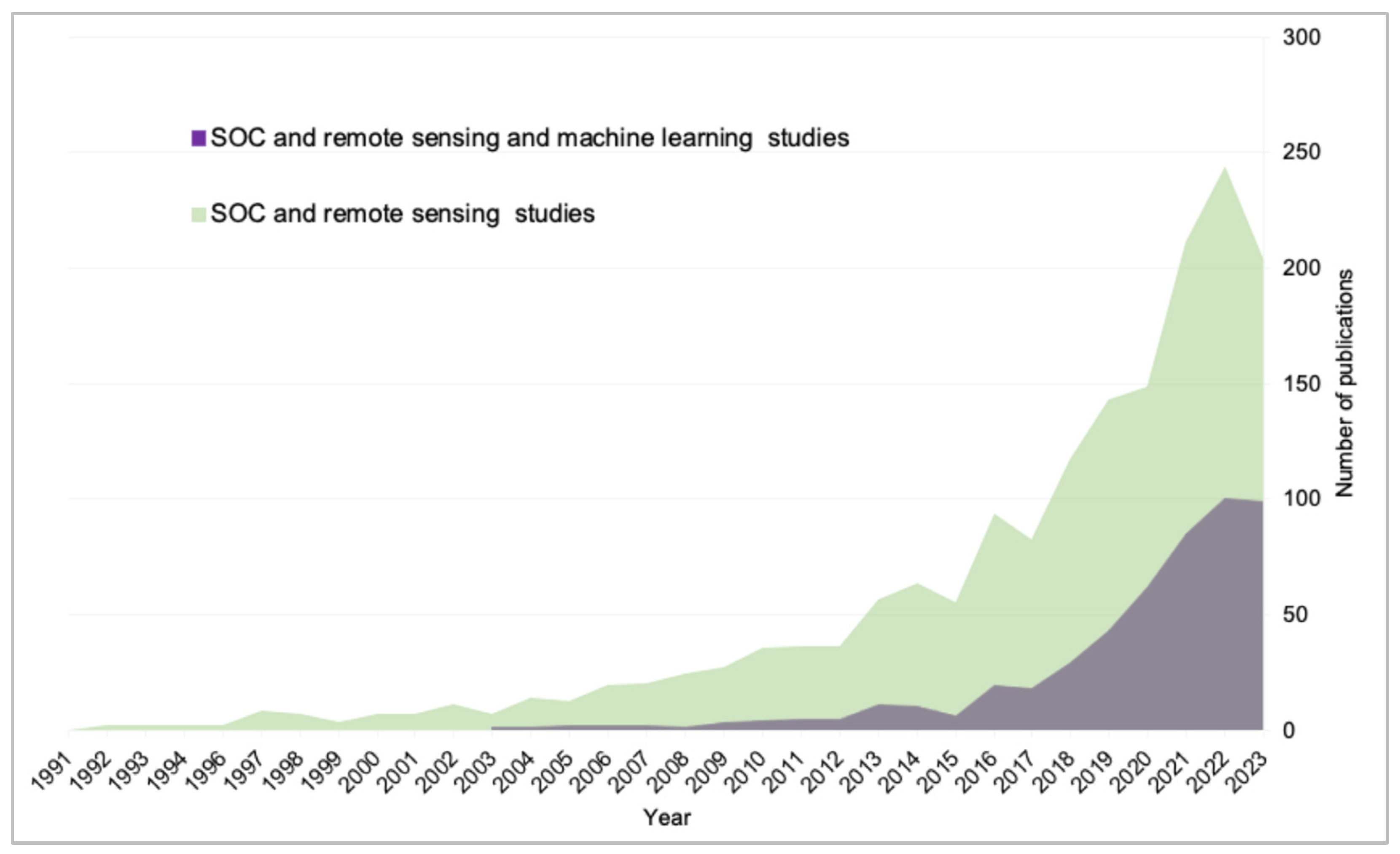
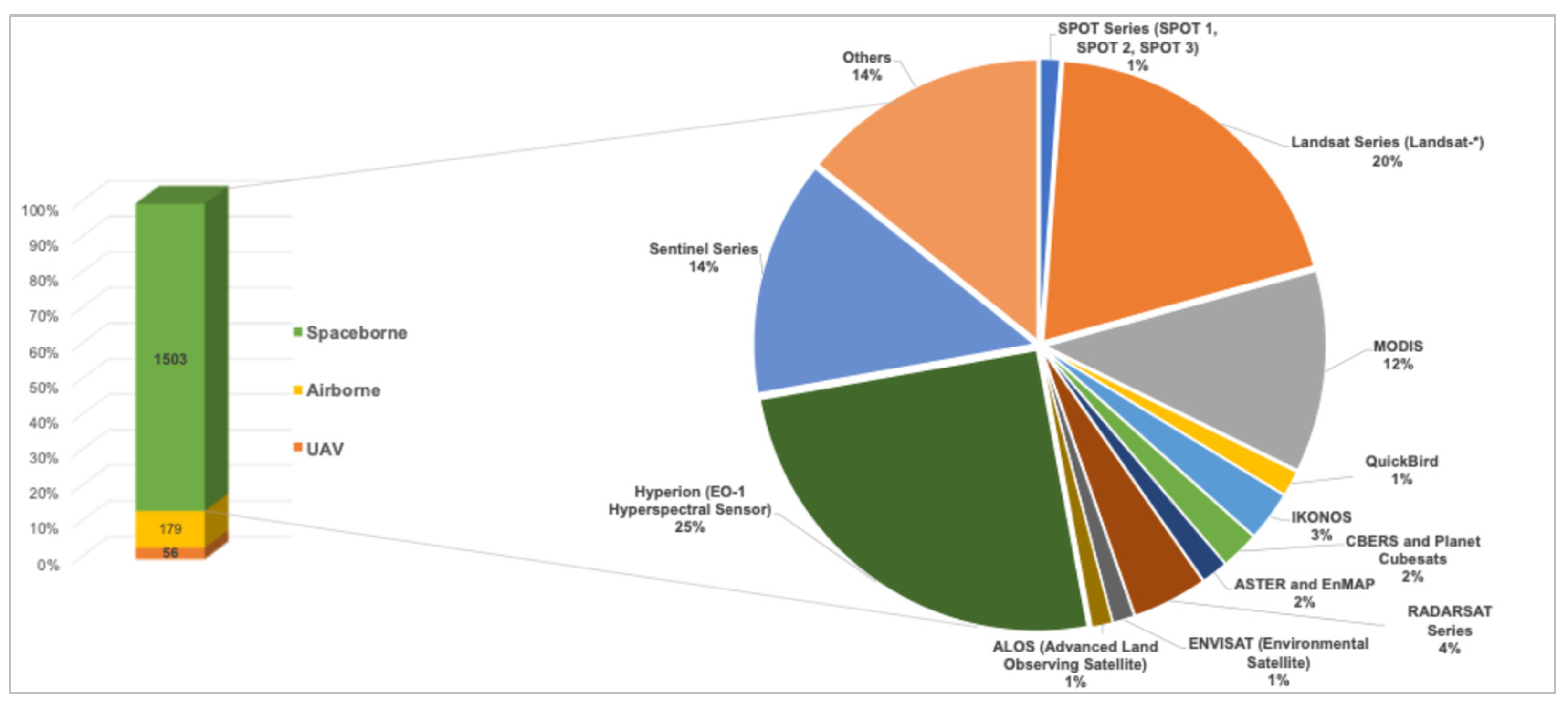


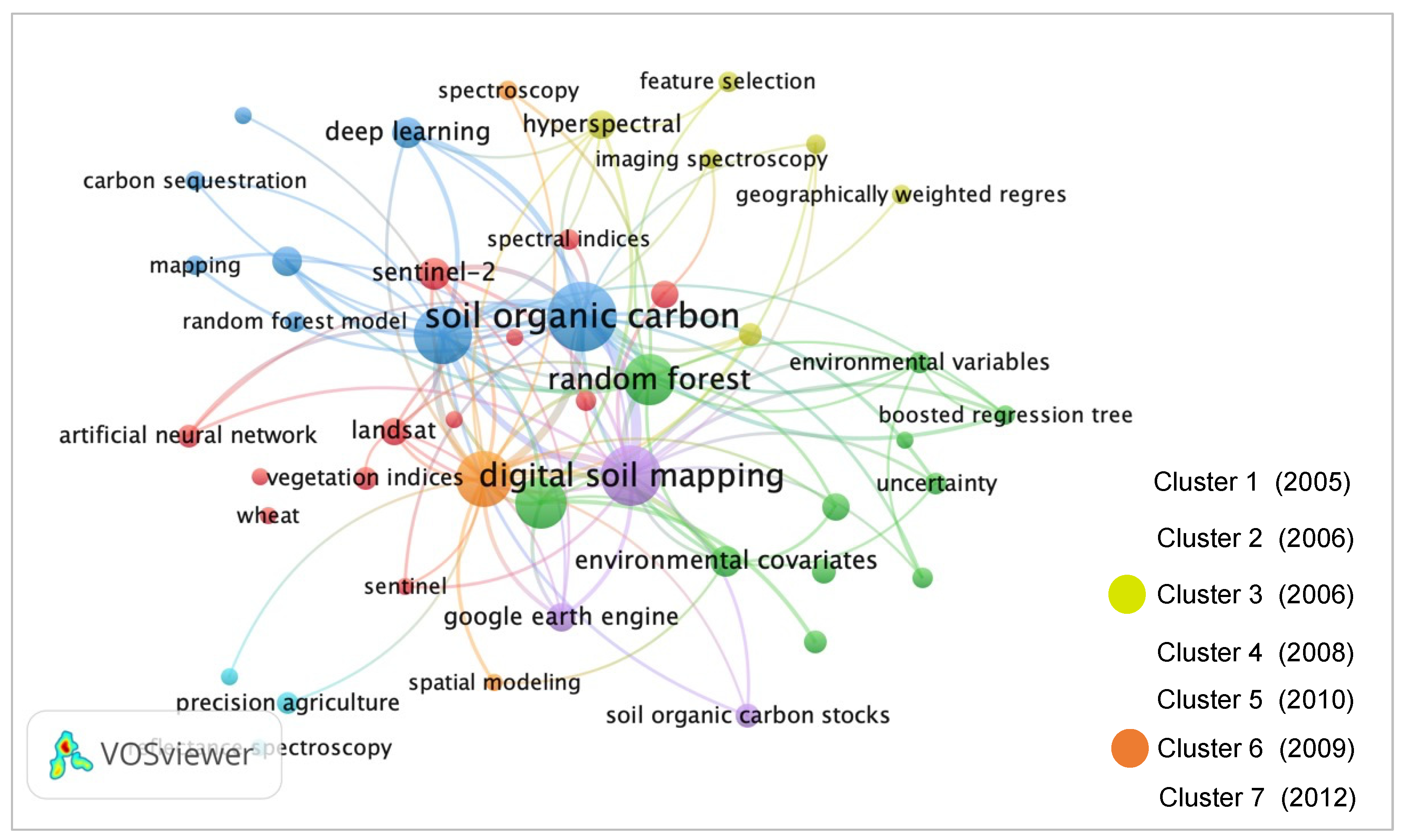
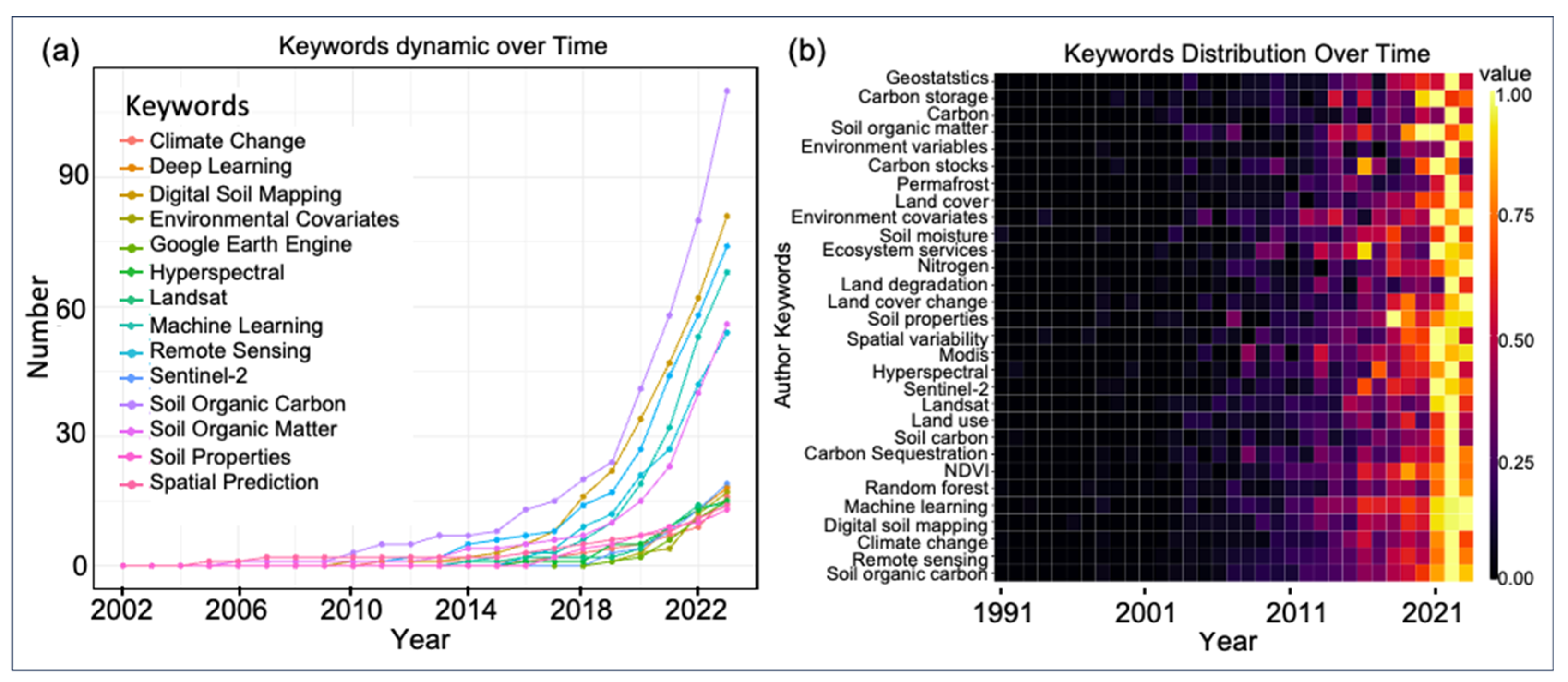
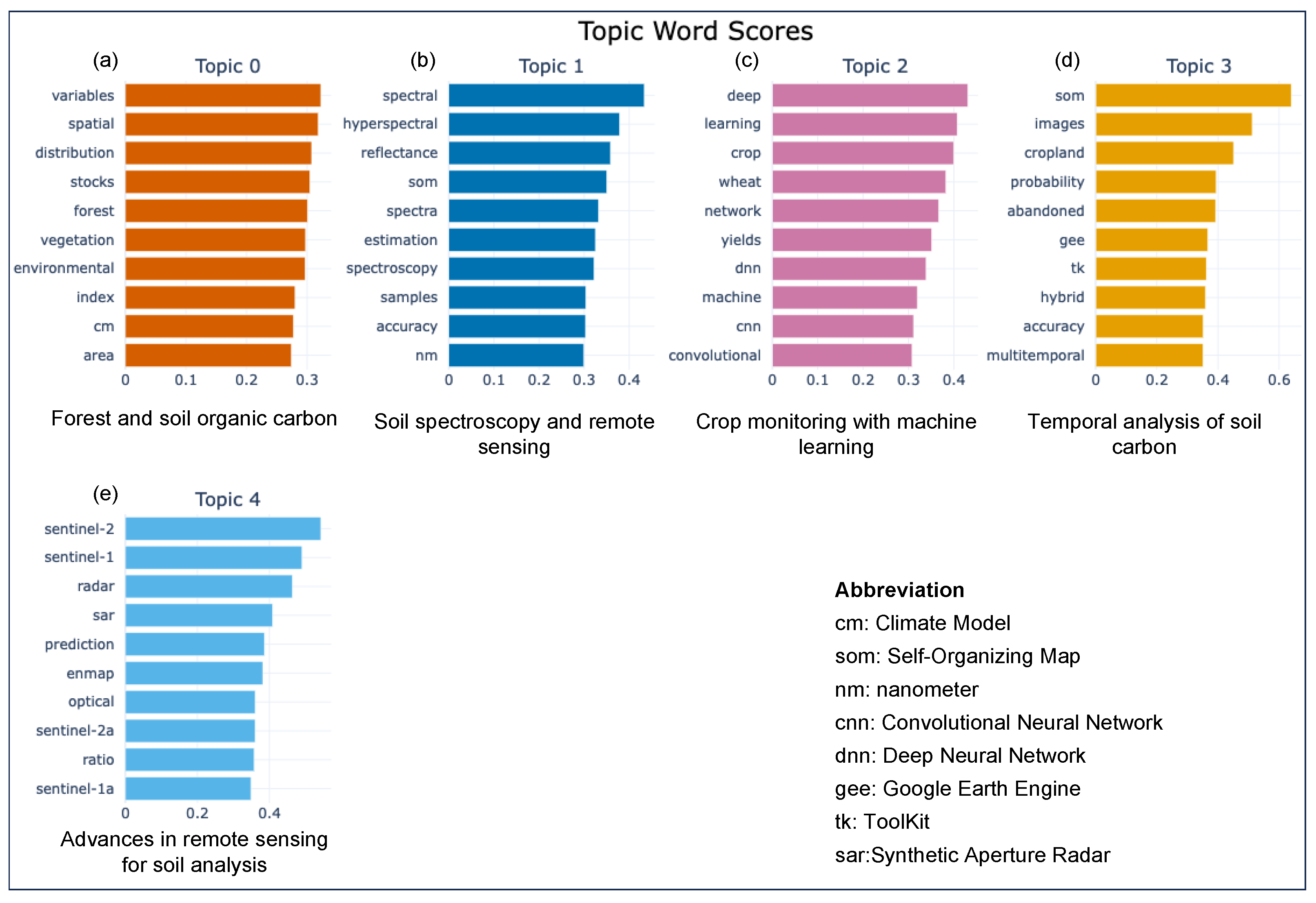
Disclaimer/Publisher’s Note: The statements, opinions and data contained in all publications are solely those of the individual author(s) and contributor(s) and not of MDPI and/or the editor(s). MDPI and/or the editor(s) disclaim responsibility for any injury to people or property resulting from any ideas, methods, instructions or products referred to in the content. |
© 2024 by the authors. Licensee MDPI, Basel, Switzerland. This article is an open access article distributed under the terms and conditions of the Creative Commons Attribution (CC BY) license (https://creativecommons.org/licenses/by/4.0/).
Share and Cite
Li, T.; Cui, L.; Wu, Y.; McLaren, T.I.; Xia, A.; Pandey, R.; Liu, H.; Wang, W.; Xu, Z.; Song, X.; et al. Soil Organic Carbon Estimation via Remote Sensing and Machine Learning Techniques: Global Topic Modeling and Research Trend Exploration. Remote Sens. 2024, 16, 3168. https://doi.org/10.3390/rs16173168
Li T, Cui L, Wu Y, McLaren TI, Xia A, Pandey R, Liu H, Wang W, Xu Z, Song X, et al. Soil Organic Carbon Estimation via Remote Sensing and Machine Learning Techniques: Global Topic Modeling and Research Trend Exploration. Remote Sensing. 2024; 16(17):3168. https://doi.org/10.3390/rs16173168
Chicago/Turabian StyleLi, Tong, Lizhen Cui, Yu Wu, Timothy I. McLaren, Anquan Xia, Rajiv Pandey, Hongdou Liu, Weijin Wang, Zhihong Xu, Xiufang Song, and et al. 2024. "Soil Organic Carbon Estimation via Remote Sensing and Machine Learning Techniques: Global Topic Modeling and Research Trend Exploration" Remote Sensing 16, no. 17: 3168. https://doi.org/10.3390/rs16173168
APA StyleLi, T., Cui, L., Wu, Y., McLaren, T. I., Xia, A., Pandey, R., Liu, H., Wang, W., Xu, Z., Song, X., Dalal, R. C., & Dang, Y. P. (2024). Soil Organic Carbon Estimation via Remote Sensing and Machine Learning Techniques: Global Topic Modeling and Research Trend Exploration. Remote Sensing, 16(17), 3168. https://doi.org/10.3390/rs16173168








